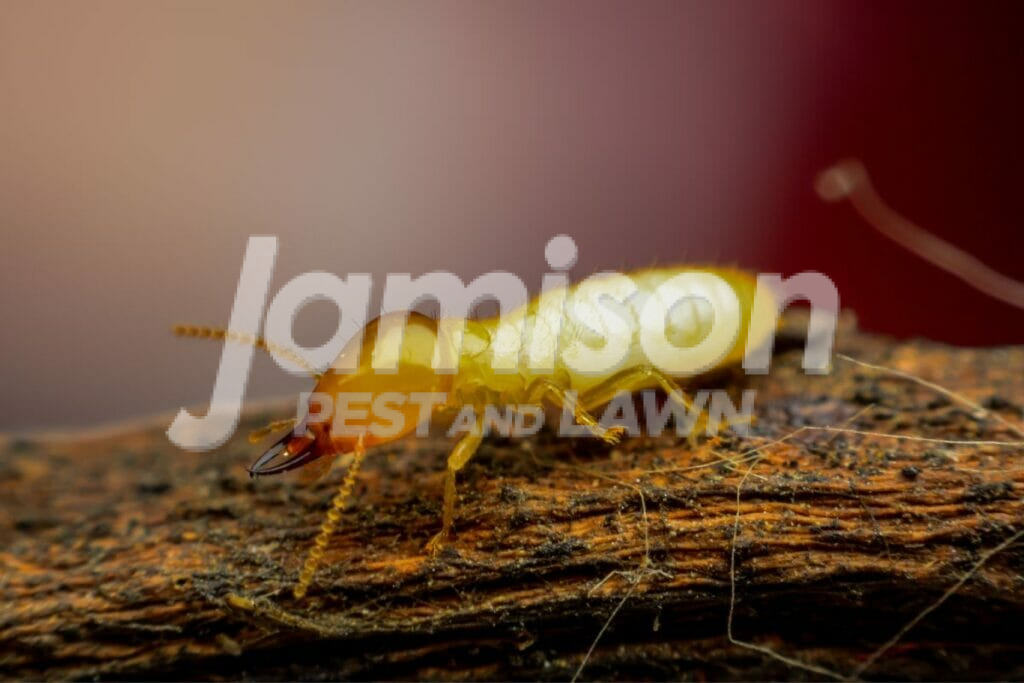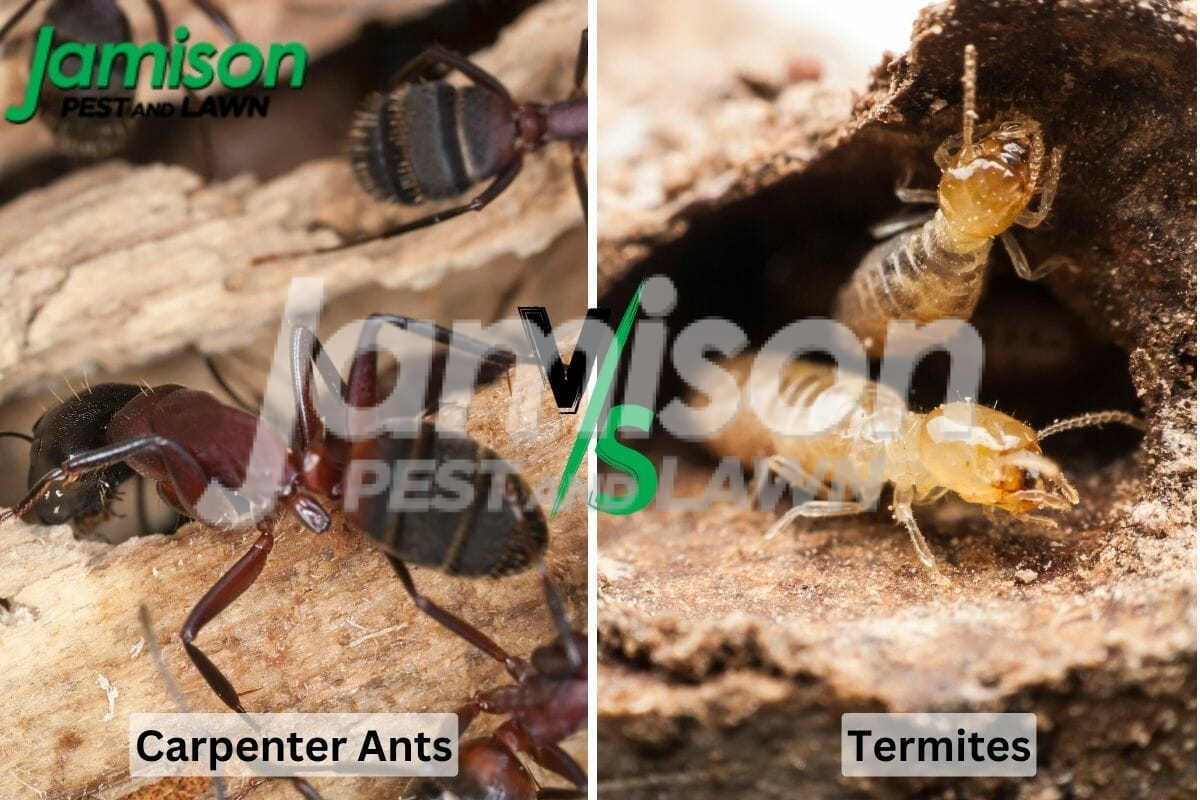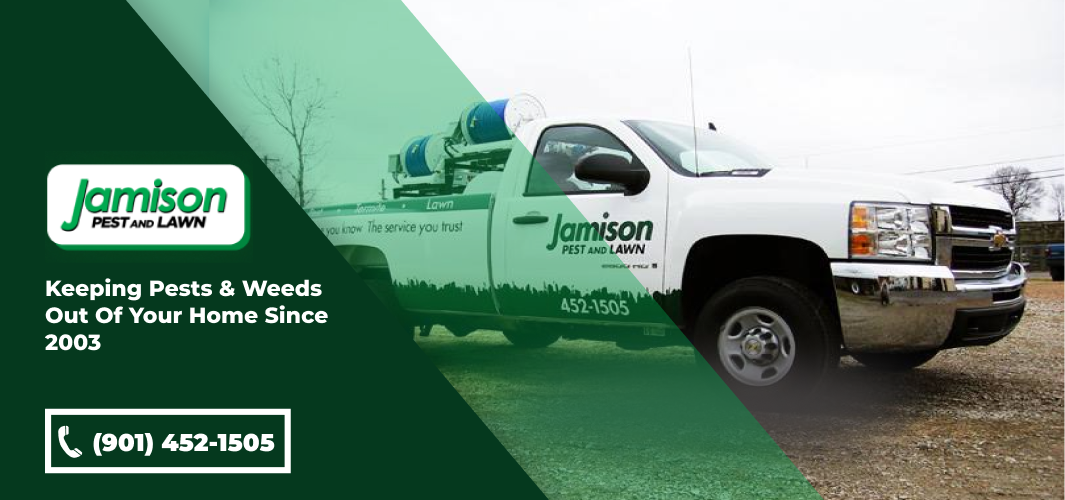When it comes to household pests, few are as destructive as carpenter ants and termites. Both are tiny, but these intruders can cause major damage to homes and buildings by wreaking havoc on wooden structures and leaving you with costly repairs.
But despite their reputation as destructive pests, many people do not realize that carpenter ants and termites are quite different. In fact, they have distinct physical characteristics, behaviors, and habitats that set them apart. Understanding these differences can make all the difference in preventing and treating infestations. So, in this blog post, we’ll take a closer look at carpenter ants vs. termites and explore what makes these two pests so unique, and how you can determine which type is infesting your home.
What Are Carpenter Ants?

Carpenter ants are pesky little creatures that can cause damage to your home.
Carpenter ants are larger ants that are named for their ability to excavate wood in order to build their nests. They are typically black, red, or a combination of the two.
Carpenter ants earned their name due to their habit of hollowing out wood to build their nests. Although they don’t consume wood like termites, they can still create considerable damage to wooden structures over time.
What Are Termites?

Termites are social insects that feed on cellulose, the main component of wood and other plant materials. Termites are known for their ability to cause significant damage to wooden structures, including homes, furniture, and even trees. They will also damage non-wood materials such as insulation and plaster. Termites can cause billions of dollars in damage each year and are considered a major pest in many parts of the world.
Termites are usually characterized into three categories:
- Subterranean Termites
- Drywood Termites
- Dampwood Termites
We have covered all there is to know about termites in our termite guide. Check it out to learn more!
Why Distinguishing Between the Two is Important
While both carpenter ants and termites can cause harm and structural damage to the wooden components of your home, it’s important to recognize the differences between them, as understanding these distinctions is crucial. Though they may cause similar forms of damage to the untrained eye, they have different behaviors, habitats, and feeding habits that require different approaches to prevent and treat infestations.
Carpenter Ants vs. Termites: The Difference
Both carpenter ants and termites differ in several ways. Continue reading to know what these differences are so that you can move ahead with extermination accordingly.
Physical Characteristics
Termites and carpenter ants are both tiny little creatures, but that’s where the similarities stop. Both these pests have different bodies and other physical features. Here are some of the differences:
Body Size
The size of both termites and carpenter ants can vary depending on the species, but as a general comparison, termites are usually smaller than carpenter ants. Termites can range from ¼ to ½ inch in length, while carpenter ants can be larger, usually ½ inch in length.
Waist Size
Carpenter ants and termites both have different waist shapes. Carpenter ants have a more detailed structure. These have a distinctive heart-shaped head and a narrow waist between their thorax and abdomen.
Termites, on the other hand, have a straight, uniform body shape with a broader waist than carpenter ants.
Antennae
Antennae are another key physical characteristic that can help distinguish between carpenter ants and termites. Carpenter ants have elbowed antennae, which means that the antennae have a sharp bend or angle in the middle. The antennae of carpenter ants are also usually longer than the width of their heads and they have small hairs along their body to help with navigation.
Termites, on the other hand, have straight antennae that are not elbowed. The antennae of termites are usually shorter than the width of their heads and may have small beads or segments along their body.
Color
Color is one of the most important distinguishing factors that can help you identify which pest is infesting your furniture and other parts of your home. Though there are chances you might miss the physical features of the insects, you can differentiate by color.
Just like other regular ants, the carpenter ants are also usually black or dark brown in color, although some species may have reddish or yellow hues.
Termites can vary in color depending on the species, but they are often a light beige or tan color. Additionally, termites may have different color variations depending on their geographic location or the materials they are feeding on. With some species, the soldiers have a darker, more distinct color than the workers or the swarmers.
Behavior
Both of these insects deal with wood damage and are a threat to your furniture, but both affect the wood differently. Let’s look at how.
Termite Behavior
Termites are one of the most destructive creatures that happen to love wood and anything made from it.
These pesky creatures feed primarily on cellulose material, which is abundantly found in wood. Other things include the likes of paper and other plant-based materials. They consume the wood as they tunnel through it to create their nests. Another thing these termites prefer is moisture, so you will likely find them near wood that has been damaged by water.
Carpenter Ant Behavior
Carpenter ants are often mistaken for termites, as both pests can cause significant damage to wooden structures. However, carpenter ants do not actually eat the wood they excavate but rather remove it to create space for their nests. In this way, they are slightly less destructive than termites but nevertheless can be worrisome.
They typically prefer to nest in moist or decaying wood and can often be found in areas with water damage, such as bathrooms, kitchens, or basements. Unlike termites, they prefer to feed on a variety of foods, including sugars, meats, and fats.
Signs To Look For in Ant and Termite Infestations
Another key aspect to help differentiate between these insects is the signs they leave behind. Each species works and leaves distinctive traces. Be alert for the following signs:
Signs of Carpenter Ant Infestation
Wood Shavings: Carpenter ants create galleries or tunnels in wood, which results in the formation of small piles of sawdust-like material known as frass. The presence of wood shavings or frass is a common sign of a carpenter ant infestation.
Damage to Wood Structures: Carpenter ants cause structural damage to wooden structures, which can be seen in the form of cracks or sagging in worse-case situations.
Signs of Termite Infestation
Unlike carpenter ants, there are several signs to look out for when it comes to a termite infestation. Here are some of them:
Mud Tubes
This is the most common sign that homeowners find first. Subterranean termites build mud tubes, which they use to travel between their nest and their food source. The presence of mud tubes is a common sign of a termite infestation.
Look for Fallen Wings
Termites often swarm in the spring, during which time they shed their wings. The presence of discarded wings around your home can be a sign of a termite infestation.
Look At The Paint
When termites tunnel close to the surface of wood or drywall, they create moisture inside the walls. This moisture can cause the paint to bubble or peel, resembling water damage. If you notice these signs without any apparent water leaks, it could be an indication of termite activity.
Conclusion
In conclusion, while carpenter ants and termites may share some similarities, their physical characteristics, behavior, and habitat are all different. Carpenter ants are known for tunneling through the wood to create their nests, while termites consume wood as food.
We hope that with this guide, you are now more aware of the things you need to know in regard to pest infestations and, therefore, can protect you and your home from a damaging infestation.
If you are unable to curb a pest infestation, it is best to get the help of a professional. With prompt and effective treatment, you can prevent further damage and ensure that your home or property remains structurally sound for years to come.
Best Pest Control Service In Memphis
Be it an ant invasion or a termite infestation, you will certainly need professional help.
This is why if you suspect an infestation of carpenter ants or termites, it’s best to contact a pest control professional who can accurately identify the species and determine the best course of treatment. This is where our team of Jamison Pest and Lawn can come to your aid.
We are a premier pest control and lawn care service provider offering termite control services in Memphis, and surrounding areas of Tennessee. With a team of professionals and years of experience, you’ll be confident you’re leaving your home in good hands. Contact us today at (901) 452-1505 to learn more about how we can help you!




